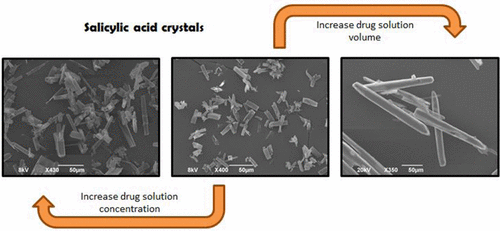当前位置:
X-MOL 学术
›
Org. Process Res. Dev.
›
论文详情
Our official English website, www.x-mol.net, welcomes your feedback! (Note: you will need to create a separate account there.)
Size and Shape Control of Micron-Sized Salicylic Acid Crystals during Antisolvent Crystallization
Organic Process Research & Development ( IF 3.4 ) Pub Date : 2017-10-31 00:00:00 , DOI: 10.1021/acs.oprd.7b00181 Teresa B. Tierney 1 , Åke C. Rasmuson 1 , Sarah P. Hudson 1
Organic Process Research & Development ( IF 3.4 ) Pub Date : 2017-10-31 00:00:00 , DOI: 10.1021/acs.oprd.7b00181 Teresa B. Tierney 1 , Åke C. Rasmuson 1 , Sarah P. Hudson 1
Affiliation

|
During an antisolvent crystallization process, micron-sized crystals of salicylic acid in the particle size range 20 to 150 μm were prepared under specific sets of crystallization conditions, with a focus on drug concentration, temperature, and solvent composition. For each experiment, the size outcome was determined by a number of knock on (often competing) influencing factors, including supersaturation, mass available for deposition during crystallization, and influence of temperature and solvent composition on crystallization kinetics. A certain fraction of the crystals, especially at higher solute concentration, developed a spectacular hollow shape with an almost perfect rectangular outer cross-section. A mechanistic explanation for the formation of hollow crystals is proposed. The use of additives during crystallization introduced further control over the size and, perhaps more noticeably, over the shape of the salicylic acid crystals. The lengths of salicylic acid crystals decreased to as low as 6 μm with increasing concentration of HPMC. Both HPMC and CMC induced a change in the crystal habit from square prisms (for the pure system) to needles, due to the structural ability of these additives to selectively attach through hydrogen bonding to the dominating 110 faces of the crystals and slow down growth in that direction. SDS exhibited less of an influence on the size, but due to its attachment to the 001 faces, it prevented indentation of these faces from occurring and thus prevented the formation of hollow crystals.
中文翻译:

反溶剂结晶过程中微米级水杨酸晶体的尺寸和形状控制
在反溶剂结晶过程中,在特定的结晶条件下,重点关注药物浓度,温度和溶剂组成,制备了粒径范围为20至150μm的水杨酸微米级晶体。对于每个实验,大小的决定因素都是由多个影响因素(通常是相互竞争的)影响的因素决定的,这些因素包括过饱和度,结晶过程中可沉积的质量以及温度和溶剂组成对结晶动力学的影响。一定比例的晶体,特别是在较高的溶质浓度下,形成了壮观的空心形状,具有几乎完美的矩形外部横截面。提出了中空晶体形成的机理解释。在结晶过程中添加剂的使用进一步控制了水杨酸晶体的尺寸,并且可能更明显地控制了水杨酸晶体的形状。随着HPMC浓度的增加,水杨酸晶体的长度降低至6μm。HPMC和CMC都引起了晶体习性的变化,从方棱镜(对于纯系统)到针状晶体,这是由于这些添加剂的结构能力是通过氢键选择性地附着在晶体的主110面上,并减慢了晶体的生长。那个方向。SDS对尺寸的影响较小,但是由于其附着在001面上,因此可以防止这些面的压痕的发生,从而可以防止中空晶体的形成。随着HPMC浓度的增加,水杨酸晶体的长度降低至6μm。HPMC和CMC都引起了晶体习性的改变,从方棱镜(对于纯系统)到针状晶体,这是由于这些添加剂的结构能力是通过氢键选择性地附着在晶体的主110面上,并减慢了晶体的生长。那个方向。SDS对尺寸的影响较小,但是由于其附着在001面上,因此可以防止这些面的压痕的发生,从而可以防止中空晶体的形成。随着HPMC浓度的增加,水杨酸晶体的长度降低至6μm。HPMC和CMC都引起了晶体习性的改变,从方棱镜(对于纯系统)到针状晶体,这是由于这些添加剂的结构能力是通过氢键选择性地附着在晶体的主110面上,并减慢了晶体的生长。那个方向。SDS对尺寸的影响较小,但是由于其附着在001面上,因此可以防止这些面的压痕的发生,从而可以防止中空晶体的形成。由于这些添加剂具有通过氢键选择性地附着在晶体的主要110面上并在该方向上减慢生长的结构能力。SDS对尺寸的影响较小,但是由于其附着在001面上,因此可以防止这些面的压痕的发生,从而可以防止中空晶体的形成。由于这些添加剂具有通过氢键选择性地附着在晶体的主要110面上并在该方向上减慢生长的结构能力。SDS对尺寸的影响较小,但是由于其附着在001面上,因此可以防止这些面的压痕的发生,从而可以防止中空晶体的形成。
更新日期:2017-11-01
中文翻译:

反溶剂结晶过程中微米级水杨酸晶体的尺寸和形状控制
在反溶剂结晶过程中,在特定的结晶条件下,重点关注药物浓度,温度和溶剂组成,制备了粒径范围为20至150μm的水杨酸微米级晶体。对于每个实验,大小的决定因素都是由多个影响因素(通常是相互竞争的)影响的因素决定的,这些因素包括过饱和度,结晶过程中可沉积的质量以及温度和溶剂组成对结晶动力学的影响。一定比例的晶体,特别是在较高的溶质浓度下,形成了壮观的空心形状,具有几乎完美的矩形外部横截面。提出了中空晶体形成的机理解释。在结晶过程中添加剂的使用进一步控制了水杨酸晶体的尺寸,并且可能更明显地控制了水杨酸晶体的形状。随着HPMC浓度的增加,水杨酸晶体的长度降低至6μm。HPMC和CMC都引起了晶体习性的变化,从方棱镜(对于纯系统)到针状晶体,这是由于这些添加剂的结构能力是通过氢键选择性地附着在晶体的主110面上,并减慢了晶体的生长。那个方向。SDS对尺寸的影响较小,但是由于其附着在001面上,因此可以防止这些面的压痕的发生,从而可以防止中空晶体的形成。随着HPMC浓度的增加,水杨酸晶体的长度降低至6μm。HPMC和CMC都引起了晶体习性的改变,从方棱镜(对于纯系统)到针状晶体,这是由于这些添加剂的结构能力是通过氢键选择性地附着在晶体的主110面上,并减慢了晶体的生长。那个方向。SDS对尺寸的影响较小,但是由于其附着在001面上,因此可以防止这些面的压痕的发生,从而可以防止中空晶体的形成。随着HPMC浓度的增加,水杨酸晶体的长度降低至6μm。HPMC和CMC都引起了晶体习性的改变,从方棱镜(对于纯系统)到针状晶体,这是由于这些添加剂的结构能力是通过氢键选择性地附着在晶体的主110面上,并减慢了晶体的生长。那个方向。SDS对尺寸的影响较小,但是由于其附着在001面上,因此可以防止这些面的压痕的发生,从而可以防止中空晶体的形成。由于这些添加剂具有通过氢键选择性地附着在晶体的主要110面上并在该方向上减慢生长的结构能力。SDS对尺寸的影响较小,但是由于其附着在001面上,因此可以防止这些面的压痕的发生,从而可以防止中空晶体的形成。由于这些添加剂具有通过氢键选择性地附着在晶体的主要110面上并在该方向上减慢生长的结构能力。SDS对尺寸的影响较小,但是由于其附着在001面上,因此可以防止这些面的压痕的发生,从而可以防止中空晶体的形成。



























 京公网安备 11010802027423号
京公网安备 11010802027423号